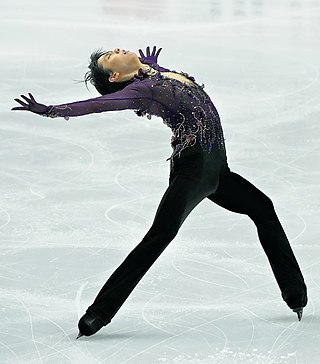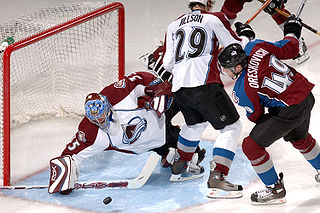
Bandy is a winter sport and ball sport played by two teams wearing ice skates on a large ice surface while using sticks to direct a ball into the opposing team's goal.

Figure skating is a sport in which individuals, pairs, or groups perform on figure skates on ice. It was the first winter sport to be included in the Olympic Games, with its introduction occurring at the 1908 Olympics in London. The Olympic disciplines are men's singles, women's singles, pair skating, and ice dance; the four individual disciplines are also combined into a team event, which was first included in the Winter Olympics in 2014. The non-Olympic disciplines include synchronized skating, Theater on Ice, and four skating. From intermediate through senior-level competition, skaters generally perform two programs, which, depending on the discipline, may include spins, jumps, moves in the field, lifts, throw jumps, death spirals, and other elements or moves.

Ice hockey is a team sport played on ice skates, usually on an ice skating rink with lines and markings specific to the sport. It belongs to a family of sports called hockey. In ice hockey, two opposing teams use ice hockey sticks to control, advance, and shoot a closed, vulcanized, rubber disc called a "puck" into the other team's goal. Each goal is worth one point. The team which scores the most goals is declared the winner. In a formal game, each team has six skaters on the ice at a time, barring any penalties, one of whom is the goaltender. Ice hockey is a full contact sport, and is considered to be one of the more physically demanding team sports. It is distinct from field hockey, in which players move a ball around a non-frozen pitch using field hockey sticks.

Spins are an element in figure skating in which the skater rotates, centered on a single point on the ice, while holding one or more body positions. They are performed by all disciplines of the sport, single skating, pair skating, and ice dance, and are a required element in most figure skating competitions. As The New York Times says, "While jumps look like sport, spins look more like art. While jumps provide the suspense, spins provide the scenery, but there is so much more to the scenery than most viewers have time or means to grasp". According to world champion and figure skating commentator Scott Hamilton, spins are often used "as breathing points or transitions to bigger things".

In many team sports that involve scoring goals, the goalkeeper is a designated player charged with directly preventing the opposing team from scoring by blocking or intercepting opposing shots on goal. Such positions exist in bandy, rink bandy, camogie, association football, Gaelic football, international rules football, floorball, handball, hurling, field hockey, ice hockey, roller hockey, lacrosse, ringette, rinkball, water polo, and shinty, as well as in other sports.
"Power play" is a sporting term used to describe a period of play where one team has a numerical advantage in players, usually due to a rule violation by the opposing team.
A hockey stick is a piece of sports equipment used by the players in all the forms of hockey to move the ball or puck either to push, pull, hit, strike, flick, steer, launch or stop the ball/puck during play with the objective being to move the ball/puck around the playing area using the stick, and then trying to score.

Figure skates are a type of ice skate used by figure skaters. The skates consist of a boot and a blade that is attached with screws to the sole of the boot. Inexpensive sets for recreational skaters are available, but most figure skaters purchase boots and blades separately and have the blades mounted by a professional skate technician.

In ice hockey, the goaltender is the player responsible for preventing the hockey puck from entering their team's net, thus preventing the opposing team from scoring. The goaltender mostly plays in or near the area in front of the net called the goal crease. Goaltenders tend to stay at or beyond the top of the crease to cut down on the angle of shots. In the modern age of goaltending there are two common styles, butterfly and hybrid. Because of the power of shots, the goaltender wears special equipment to protect the body from direct impact.
The toe loop jump is the simplest jump in the sport of figure skating. It was invented in the 1920s by American professional figure skater Bruce Mapes. The toe loop is accomplished with a forward approach on the inside edge of the blade; the skater then switches to a backward-facing position before their takeoff, which is accomplished from the skater's right back outside edge and left toepick. The jump is exited from the back outside edge of the same foot. It is often added to more difficult jumps during combinations and is the most common second jump performed in combinations. It is also the most commonly attempted jump.
In ice hockey, a play is offside if a player on the attacking team does not control the puck and is in the offensive zone when a different attacking player causes the puck to enter the offensive zone, until either the puck or all attacking players leave the offensive zone. Simply put, the puck must not enter the attacking zone after attacking players. If a player on the attacking team is in the offensive zone before the puck, either an immediate offside occurs, or they must retreat to the neutral zone.

In ice hockey, an official is a person who has some responsibility for enforcing the rules and maintaining the order of the game. There are two categories of officials, on-ice officials, who are the referees and linesmen that enforce the rules during gameplay, and off-ice officials, who have an administrative role rather than an enforcement role.

Roller in-line hockey, American roller hockey or inline hockey, is a variant of hockey played on a hard, smooth surface, with players using inline skates to move and ice hockey sticks to shoot a hard, plastic puck into their opponent's goal to score points. The sport is a very fast-paced and free-flowing game and is considered a contact sport, but body checking is prohibited. There are five players including the goalkeeper from each team on the rink at a time, while teams normally consist of 16 players. There are professional leagues, one of which is the National Roller Hockey League (NRHL). While it is not a contact sport, there are exceptions, i.e. the NRHL involves fighting.

In ice hockey, the goaltender wears specialized goaltending equipment to protect themselves from the impact of the puck, and to assist in making saves. Ringette and rinkball goaltenders use the same equipment with some exceptions. This article deals chiefly with the sport of ice hockey.
This is a list of common terms used in the sport of ice hockey along with the definitions of these terms.
The following is a glossary of figure skating terms, sorted alphabetically.

The death spiral is a figure skating term used to describe a spin involving two partners in the discipline of pair skating, in which one partner lowers the other partner while the partner getting close to the ice arches backward on one foot. It was created by German professional skater Charlotte Oelschlägel and her husband Curt Newmann in the 1920s. Suzanne Morrow and Wallace Diestelmeyer from Canada were the first pair team to perform the death spiral one-handed, at the 1948 Olympic Games. In the 1960s, Soviet pair team Liudmila Belousova and Oleg Protopopov created three death spirals: "the backward-inside, forward-inside and forward-outside death spirals, which they originally named the Cosmic Spiral, Life Spiral and Love Spiral, respectively". The International Skating Union (ISU), the governing body that oversees figure skating, allows for variations of arm holds and pivot positions. Senior pair skating teams must perform different types of death spirals in their short programs and free skating programs.
Crossovers are a basic stroking technique in figure skating for gaining impetus while skating along a curve or circle. They may be performed while skating either forwards or backwards.

In ice hockey, players use specialized equipment both to facilitate the play of the game and for protection as this is a sport where injuries are common, therefore, all players are encouraged to protect their bodies from bruises and severe fractures.
British Ice Skating is the national governing body of ice skating within the United Kingdom. Formed in 1879, it is responsible for overseeing all disciplines of ice skating: figure skating ; synchronised skating; and speed skating.











